Estate Jewelry: Mystery Pearls and Secret Love Messages
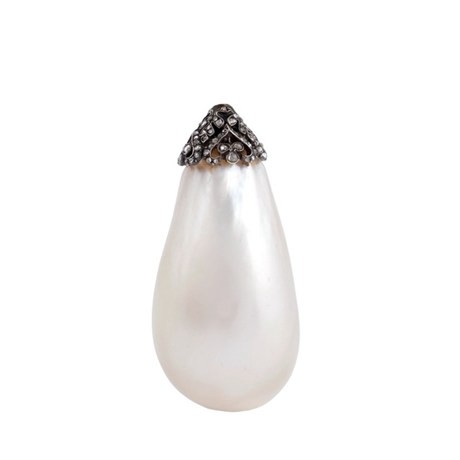
Next week, London jewelers Symbolic & Chase will be showcasing an historic pearl at the Masterpiece London art and antiques fair.
The pearl, which they believe was owned by Mary Tudor (daughter of Henry VIII and Catherine of Aragon and Queen of England from 1553–1558), was put up for auction at Christie’s in 2004 by an anonymous family and bought by Symbolic & Chase for $282,090. Since then, the company has determined that this is the pearl depicted in various royal portraits of Mary Tudor, and not the famous “La Peregrina” pearl, which is probably best known for having been bought by Richard Burton as a gift for Elizabeth Taylor. Dates are key, here: Philip II of Spain gave Mary the pearl in question as an engagement gift in 1554, but La Peregrina was not officially documented until 1579. (Note: La Peregrina fetched just under $12 million as part of the 2011 “The Collection of Elizabeth Taylor: The Legendary Jewels” auction at Christie’s, and Mary Tudor was not mentioned in the provenance notes.) It’s an interesting tale, and there’s a little more info and a collection of the portraits here.
There’s obviously a lot of information that is not being made available about this pearl — whoever put it up for sale in 2004 continues to prefer anonymity — and I’m dying to know more about the research path that led S&C to their conclusion. Apparently they’ve used 16th-century inventory records that identify the pearl by weight, and more info will be available at Masterpiece.
Following its appearance at the Fair, the Mary Tudor pearl will be included in the Pearls exhibit at the Victoria and Albert Museum in London, running from September 21, 2013 — January 19, 2014.
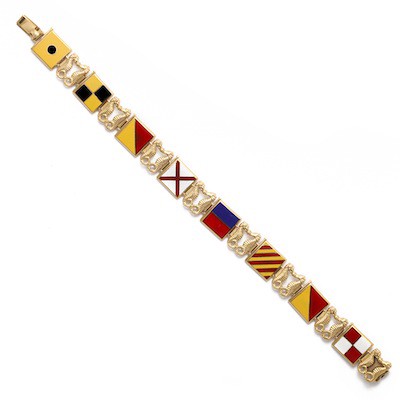
In a cute twist on secret message jewelry, this American bracelet spells out “I LOVE YOU” in Naval signal flags of 14k gold and enamel. Tiny seahorses separate the flags. Circa 1930.
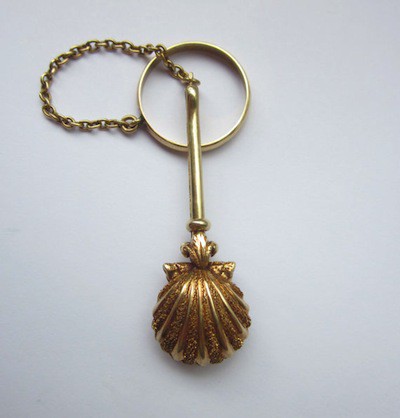
This delicate 14k gold shell, circa 1871, may have originally been used as a dress holder or “skirt lifter” — an ingenious little contraption designed to prevent dress hems from being dragged along the ground. Nice ones are fairly rare (particularly ones like the spectacular bejeweled version I featured a while back), and this one is so small and genteel I think it was probably used more as a handkerchief holder than a dress lifter. It is engraved “H. Aver Dec. 25/71,” leading the dealer to wonder if it was originally a Christmas gift.
(Note: In the past, some commenters have expressed reservations about buying antique jewelry through Etsy. It’s a valid concern, so I want to mention that I have personally bought from this dealer in the past, and had a great experience.)
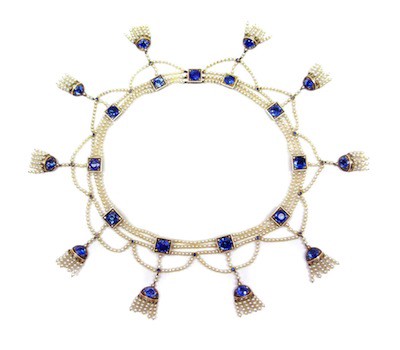
Circa 1900, this stunning fringe necklace features strands, swags and tassels of seed pearls, with bright box collet-set (a.k.a. bezel-set, but with the gold in a continuous box shape rather than set flush against the stones) sapphires placed throughout. Tiny rose-cut diamonds and white enamel provide further highlights.
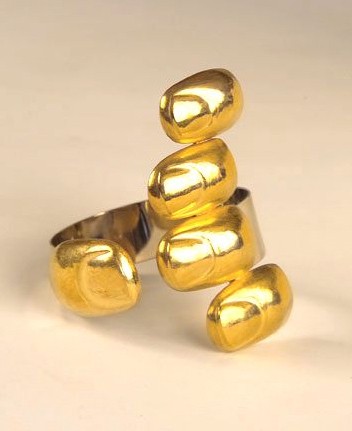
Bruno Martinazzi is a 20th century Italian jeweler and sculptor renowned for using the human body — mainly lips and hands — as a subject in his work. Circa 1968, this 18k “Goldfinger” bracelet is one of his most famous designs. It raises questions as to its meaning: A man’s hand is encircling a woman’s wrist, but is it a gesture of love, or of restraint? (According to Yvonne J. Markowitz, Curator of Jewelry for the Museum of Fine Arts, Boston, the piece “represents the creative urge and the point of contact between two individuals.”)
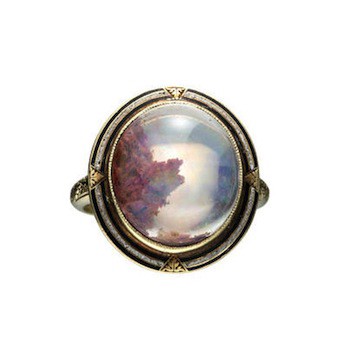
This unusual Victorian ring features a cabochon-cut opal set in an engraved 14k gold ring with black and white enamel detailing. The amazing part, though, is that opal — the stone has inclusions that look like reddish-brown moss, which makes it resemble a tiny, hazy, mystical little landscape. I want to go in there.
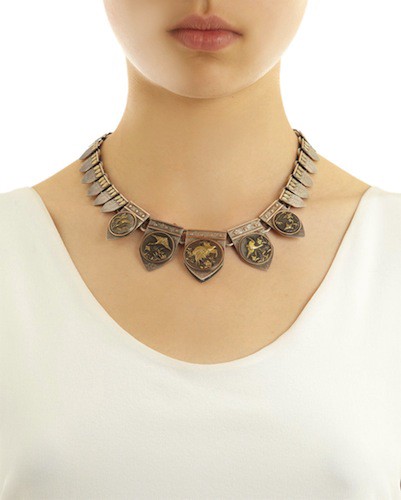
I’ve featured shakudo, the Japanese mixed-metal alloy before, but I love this collar. Circa 1880, it’s silver, with gold detailing and five shakudo discs featuring natural bird and floral motifs.

“Eccentric” mouse jewelry became popular in England in the 1880s, following a trend that had begun in France. London’s Walter Thornhill & Co. were particularly known for their mouse jewelry, and the pieces, which were often sold as lucky charms, were quirky and unusual. This 15k gold Thornhill bangle, circa 1880s, features a push-button closure and safety chain.
The British Museum has a similar Thornhill bracelet in their collection, as well as two rings (pictured with the bracelet) that feature tiny mice, which are designed to revolve around the band.
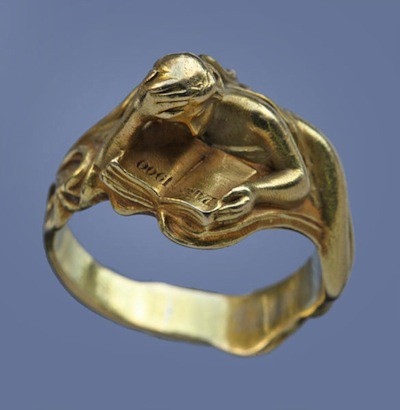
If I could build a time machine, I would specifically engineer it to take me to all of the World’s Fairs. The Philadelphia Centennial Exposition of 1876 would be my first stop (my hometown, yo), and after that, I would probably attend them all in order starting with the first — the Great Exhibition in London’s Crystal Palace in 1851. (I’ve thought about this, can you tell?)
I know I would be sorely tempted, however, to skip ahead to see the Paris Exposition Universelle of 1900. The Art Nouveau style had begun to make appearances at Fairs prior to this one, but the 1900 Exposition was where it gained the most exposure, with over 50 million people attending from all over the world. The great Art Nouveau jeweler René Lalique was working at the height of his artistic career at this point, and the impact of the magnificent jewelry designs he showed at the Exposition reverberated throughout the design world — and resulted in knockoffs galore, of course. Tiffany & Co. also had an excellent showing at this Exposition, where they won various awards for both their gems and their jewelry.
Circa 1900, this golden Art Nouveau ring celebrates the Paris Exposition. By Louis Zorra (an Italian designer who worked in Paris), it depicts a reclining woman immersed in a book that reads “Paris 1900.” The ring is included in a selling exhibition at London’s Tadema Gallery called “Nymphs, Goddesses & Femmes Fatales,” which focuses on the portrayal of the female form at the turn of the 20th century. If you’re in London, stop by; the exhibit closes on June 29th.
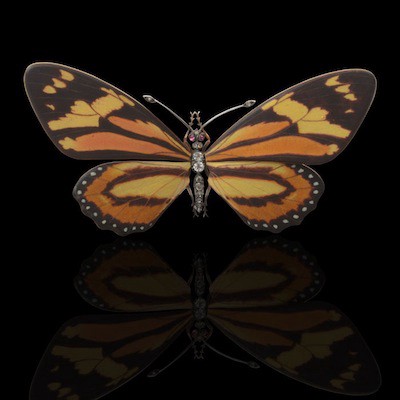
Speaking of Lalique: this magnificent Lalique butterfly brooch, circa 1895, features wings of polychrome enamel (i.e., enamel in multiple colors) with a satin finish. The body of the butterfly is silver and 18k yellow gold, set with 13 old- and rose-cut diamonds and two cabochon rubies. Lalique himself liked this piece so much that he gave it to his own daughter, Suzanne Lalique-Haviland, and it remained in her collection until around 1989, the year of her death.
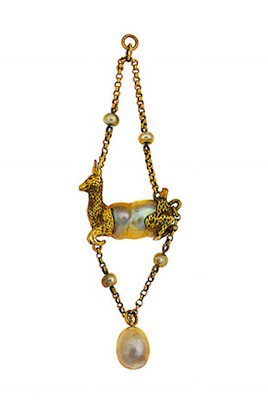
I don’t normally like to include jewelry that’s already sold, but this pendant is worth a mention. It was included in the Christie’s “Jewellery” auction in London on Wednesday, and it dates to the late 16th/ early 17th centuries. In it, the designer used a large baroque pearl as the basis for the body of a leaping doe, adding a front and hindquarters of textured gold. The doe is suspended by two pearl-set chains, with a larger pearl drop below. The piece sold for $5,474 (cheap, if you ask me, especially compared with much of the comparably-priced but boring contemporary jewelry that’s out there).
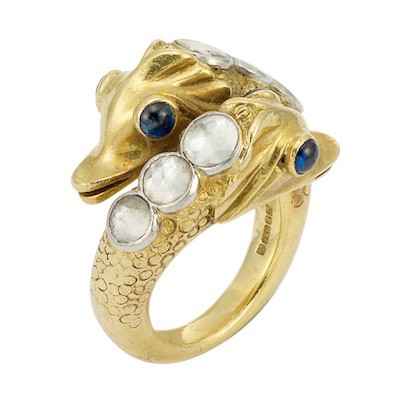
This 18k gold snake ring — although it looks more like a little sea serpent to me — is set with foil-backed diamonds and cabochon sapphires, and it’s so adorable it broke my face. It’s by contemporary jewelry designer Elizabeth Gage, and it’s also sold (sorry!). It was auctioned yesterday in Doyle New York’s Fine Jewelry sale, and went above estimate at $2,813 (paired in one lot with another ring that wasn’t remotely as cute).
Previously: Theft, Mosquitoes, and the Slipper Acrostic Ring
Monica McLaughlin can be reached at [email protected].